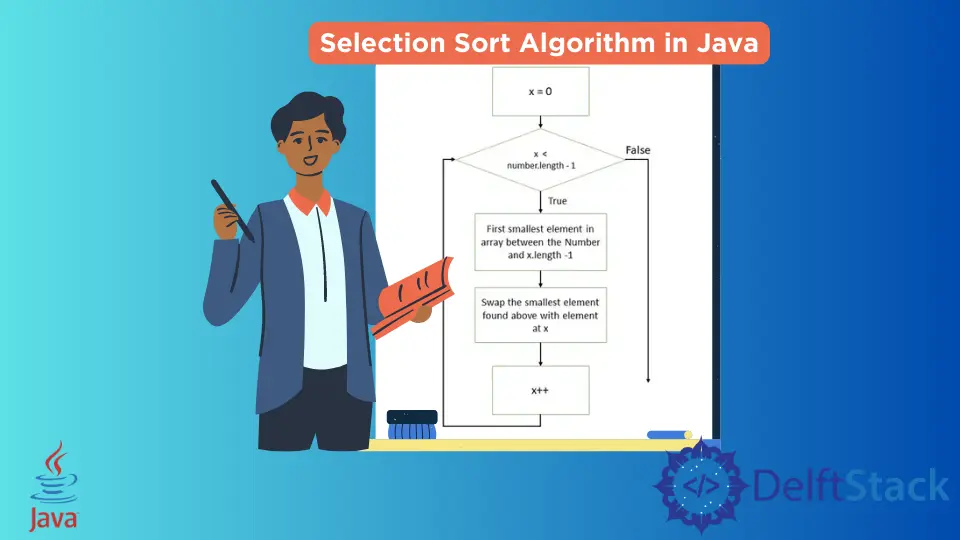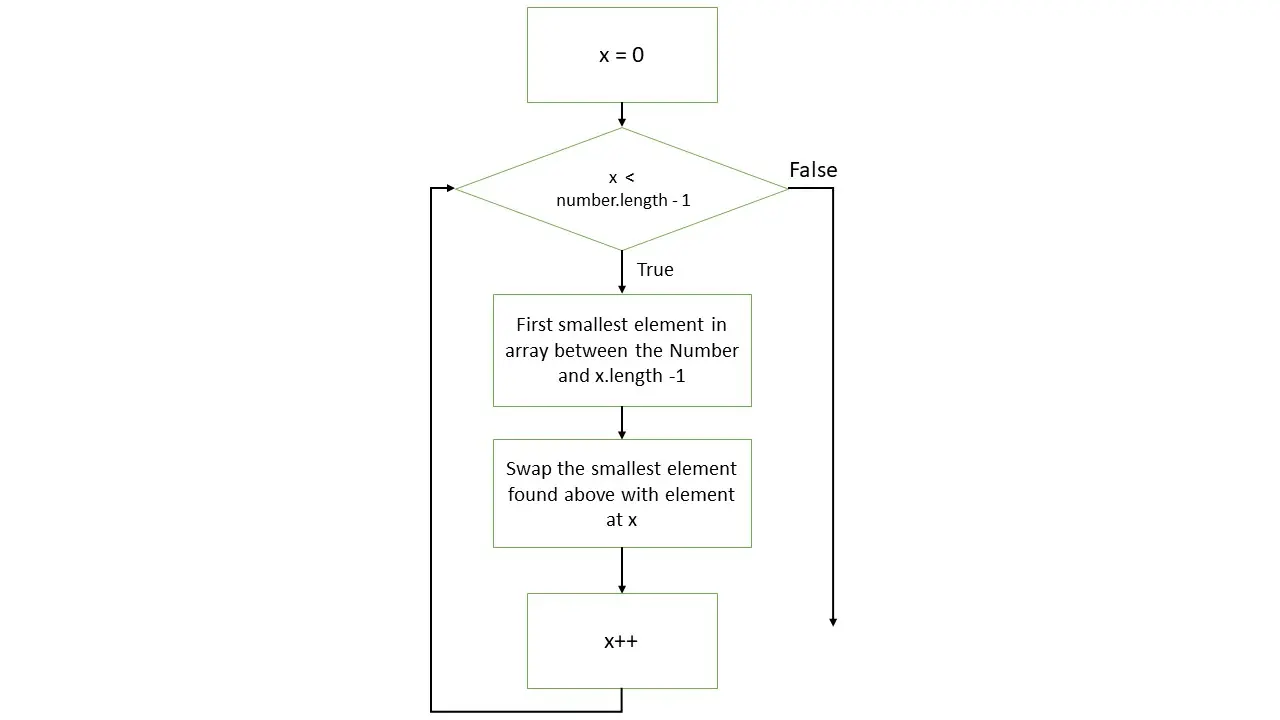Java 中的選擇排序演算法
Sheeraz Gul
2023年10月12日

選擇排序是首先選擇列表或陣列中最小的元素並與第一個元素或陣列交換的方法;然後,第二個縮小的元素與第二個元素交換。重複此過程,直到對整個列表或陣列進行排序。
本教程將演示選擇排序的工作原理以及如何在 Java 中實現它。
Java 中的選擇排序演算法
選擇排序演算法有四個主要步驟:
-
將第一個元素值設定為
minimum。 -
將
minimum與第二個元素進行比較,如果第二個元素較小,則將該元素設定為minimum。對第三個元素重複該過程,如果第三個元素較小,則將minimum分配給第三個元素。 -
重複該過程,直到從列表中找到
minimum元素。然後將該最小元素與第一個元素交換,並在那裡完成一次迭代。 -
下一次迭代是對第二個元素重複該過程。
-
重複這個過程,直到所有元素都交換到它們對應的位置。
下面的流程圖演示了選擇排序演算法的整個過程:

在 Java 中實現選擇排序演算法
讓我們用 Java 實現上述演算法。
例子:
package delftstack;
import java.util.*;
public class Selection_Sort {
static void select_sort(int Demo_Array[]) {
int length = Demo_Array.length;
// traversing the unsorted array
for (int x = 0; x < length - 1; x++) {
// finding the minimum element in the array
int minimum_index = x;
for (int y = x + 1; y < length; y++) {
if (Demo_Array[y] < Demo_Array[minimum_index])
minimum_index = y;
}
// Swapping the elements
int temp = Demo_Array[minimum_index];
Demo_Array[minimum_index] = Demo_Array[x];
Demo_Array[x] = temp;
}
}
public static void main(String args[]) {
// Original Unsorted Array
int Demo_Array[] = {6, 2, 1, 45, 23, 19, 63, 5, 43, 50};
System.out.println("The Original Unsorted Array: \n" + Arrays.toString(Demo_Array));
// call selection sort
select_sort(Demo_Array);
// print the sorted array
System.out.println("Sorted Array By the Selection Sort: \n" + Arrays.toString(Demo_Array));
}
}
上面的程式碼實現了上述陣列的選擇排序。
輸出:
The Original Unsorted Array:
[6, 2, 1, 45, 23, 19, 63, 5, 43, 50]
Sorted Array By the Selection Sort:
[1, 2, 5, 6, 19, 23, 43, 45, 50, 63]
讓我們通過輸入陣列大小和元素來嘗試另一種方式。
例子:
package delftstack;
import java.util.Arrays;
import java.util.Scanner;
public class Selection_Sort {
public static void main(String args[]) {
int Array_Size;
Scanner Array_Scan = new Scanner(System.in);
System.out.print("Enter the size of the Array : ");
Array_Size = Array_Scan.nextInt();
int Demo_Array[] = new int[Array_Size];
System.out.print("Enter the elements of the Array : ");
for (int x = 0; x < Array_Size; x++) {
Demo_Array[x] = Array_Scan.nextInt();
}
System.out.println("The Original Unsorted Array: \n" + Arrays.toString(Demo_Array));
// Sorting Array using Selection Sort Technique
for (int x = 0; x < Array_Size; x++) {
for (int y = x + 1; y < Array_Size; y++) {
if (Demo_Array[x] > Demo_Array[y]) {
int temp = Demo_Array[x];
Demo_Array[x] = Demo_Array[y];
Demo_Array[y] = temp;
}
}
}
System.out.println("The array after selection sort: \n" + Arrays.toString(Demo_Array));
}
}
程式碼將首先要求輸入陣列的大小,然後要求輸入陣列的元素,最後使用選擇排序對給定的陣列進行排序。
輸出:
Enter the size of the Array : 10
Enter the elements of the Array :
12
23
45
21
45
64
1
3
45
67
The Original Unsorted Array:
[12, 23, 45, 21, 45, 64, 1, 3, 45, 67]
The array after selection sort:
[1, 3, 12, 21, 23, 45, 45, 45, 64, 67]
作者: Sheeraz Gul
Sheeraz is a Doctorate fellow in Computer Science at Northwestern Polytechnical University, Xian, China. He has 7 years of Software Development experience in AI, Web, Database, and Desktop technologies. He writes tutorials in Java, PHP, Python, GoLang, R, etc., to help beginners learn the field of Computer Science.
LinkedIn Facebook